Currency: 16 annas = 1 rupee; from 1 April 1957 100 naye paise = 1 rupee
Postal context
A postal service was operated in Bahrain by the Indian postal administration in Bombay from 1884. With the independence of India in 1947 responsibility passed to the British GPO on 1 April 1947, though the postal services remained under the control of Karachi, transferring from Indian to Pakistani administration in August 1947 until the British GPO was ready to take over on 1 April 1948. For this reason the previously overprinted Indian stamps were replaced by overprinted GB stamps in 1948.
On 31 December 1965 the GB postal administration was closed and control handed over to the Bahrain postal department on 1 January 1966, though the overprinted stamps had been replaced by a set inscribed “Bahrain” in 1960.
King George VI
1st definitive set, 1948
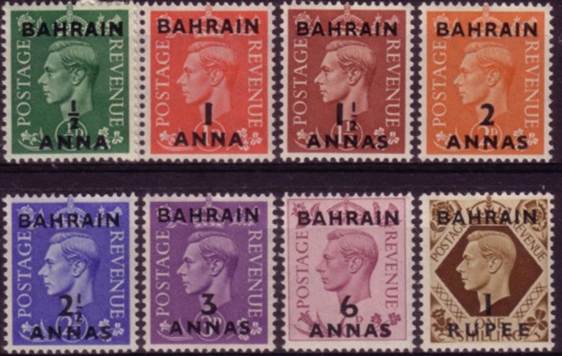
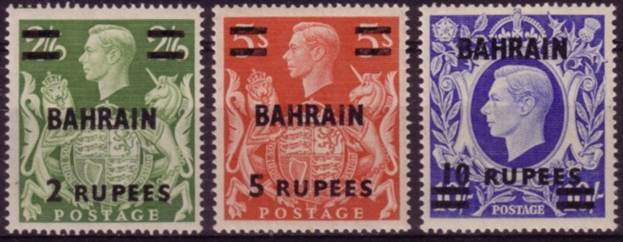
| (SG №) | denomination | colour | date of issue | number issued |
| 51 | ½ anna on ½d | green | 1 April 1948 | 481,713 |
| 52 | 1 anna on 1d | red | 1 April 1948 | 465,689 |
| 53 | 1½ annas on 1½d | brown | 1 April 1948 | 213,418 |
| 54 | 2 annas on 2d | orange | 1 April 1948 | 484,939 |
| 55 | 2½ annas on 2½d | blue | 1 April 1948 | 198,928 |
| 56 | 3 annas on 3d | violet | 1 April 1948 | 1,138,523 |
| 57 | 6 annas on 6d | purple | 1 April 1948 | 2,152,034 |
| 58 | R1 on 1s | brown | 1 April 1948 | 423,706 |
| 59 | R2 on 2/6d | green | 1 April 1948 | 46,709 |
| 60 | R5 on 5s | red | 1 April 1948 | 42,379 |
| 60a | R10 on 10s | blue | 4 July 1949 | 16,460 |
On the corner block for the R1 on 1s there is a very faint “ghost” of a control “O44”, which should have been properly deleted as no longer relevant or accurate.
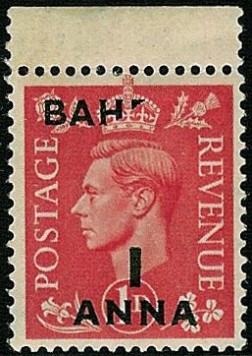
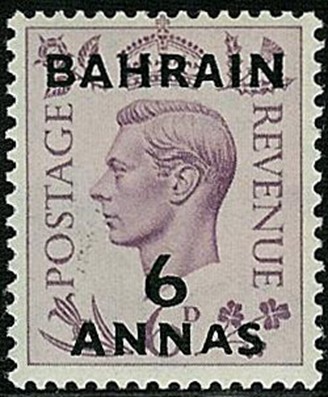
| Varieties | ||
| 52.v1 | 1 anna | overprint partially omitted (1 copy known) |
| 57.v1 | 6 annas | very thin second “A” in “ANNAS” |
Silver Wedding, 1948
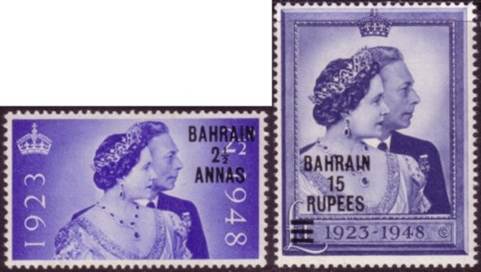
| (SG №) | denomination | colour | date of issue | number issued |
| 61 | 2½ annas on 2½d | blue | 26 April 1948 | 186,095 |
| 62 | R15 on £1 | dark blue | 26 April 1948 | 21,984 |
Olympic Games, 1948
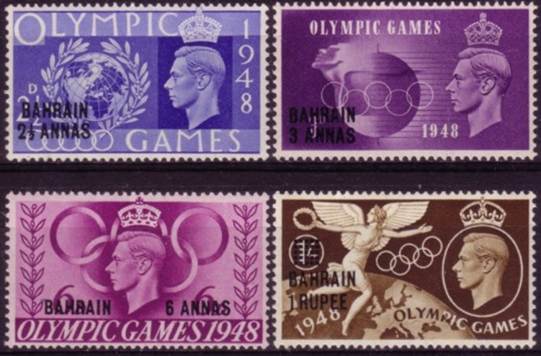
| (SG №) | denomination | colour | date of issue | number issued |
| 63 | 2½ annas on 2½d | blue | 29 July 1948 | 99,304 |
| 64 | 3 annas on 3d | violet | 29 July 1948 | 112,515 |
| 65 | 6 annas on 6d | purple | 29 July 1948 | 112,919 |
| 66 | R1 on 1s | brown | 29 July 1948 | 87,858 |
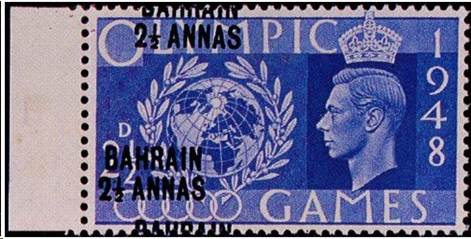
| Varieties | ||
| 63.v1 | 2½ annas | overprint double (1 sheet of 120 copies) |
The extra overprint slants slightly so its position varies according to the position of the stamp on the sheet. Image courtesy of Sandafayre auctions
UPU, 1949
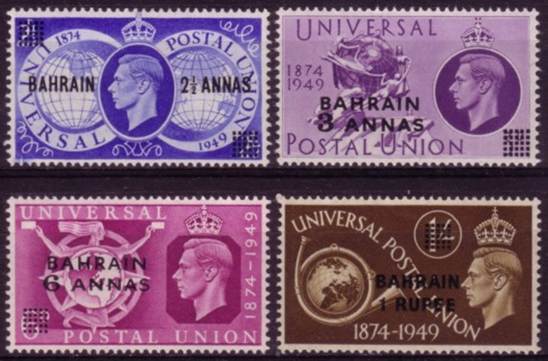
| (SG №) | denomination | colour | date of issue | number issued |
| 67 | 2½ annas on 2½d | blue | 10 October 1949 | 93,689 |
| 68 | 3 annas on 3d | violet | 10 October 1949 | 105,246 |
| 69 | 6 annas on 6d | purple | 10 October 1949 | 105,064 |
| 70 | R1 on 1s | brown | 10 October 1949 | 50,853 |
2nd Definitive set, 1951
The colour of the low values was changed to retain conformity with UPU requirements; the release date of these and the new high values was to coincide with the Festival of Britain. The 4 annas value was issued first, the year before the Festival.
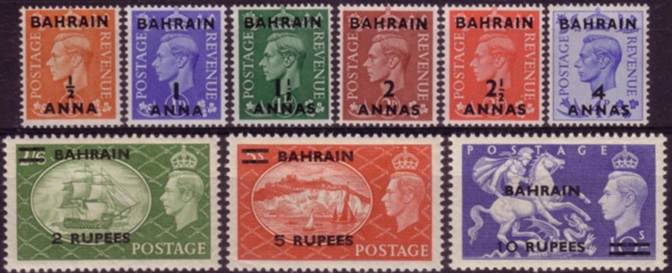
| (SG №) | denomination | colour | date of issue | number issued |
| 71 | ½ anna on ½d | orange | 3 May 1951 | 407,547 |
| 72 | 1 anna on 1d | blue | 3 May 1951 | 347,155 |
| 73 | 1½ annas on 1½d | green | 3 May 1951 | 155,944 |
| 74 | 2 annas on 2d | brown | 3 May 1951 | 374,277 |
| 75 | 2½ annas on 2½d | red | 3 May 1951 | 171,900 |
| 76 | 4 annas on 4d | blue | 2 October 1950 | 304,323 |
| 77 | R2 on 2/6d | green | 3 May 1951 | 40,000 |
| 78 | R5 on 5s | red | 3 May 1951 | 38,937 |
| 79 | R10 on 10s | blue | 3 May 1951 | 28,994 |
Later printings of the 2 Rupees value


Type I: “2” level with “RUPEES”
Type II: “2” slightly above “RUPEES”, 15mm between lines
Type III: as type II but 16mm between lines, bottom line further left – “2” clear of “Bahrain”.
Type III appears to have been an emergency printing, as the Queen Elizabeth “castle” set was released shortly afterwards. Mint copies are extremely scarce as the difference in overprint was not noticed at the time of issue.
| (SG №) | denomination | colour | date of issue | number issued |
| 77a | R2 on 2/6d, type II | green | 1953 | 14,000 |
| 77b | R2 on 2/6d, type III | green | 1955 | 6,000 |


| Varieties | ||
| 77.v1 | R5 type I | thin extra bar (beware forgeries) |
| 78.v1 | R2 type III | raised “I” in “BAHRAIN” |
Queen Elizabeth
Tudor Crown watermark, 1952
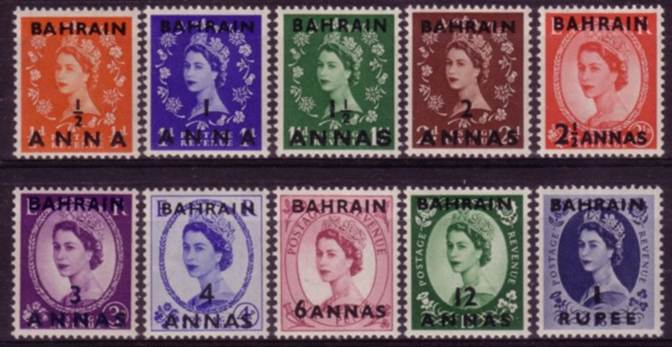
Fonts: The 1½, 2½, 3 and 6 annas retain the font of the G6 set, in which the “H” is 2.1mm tall; on the other values the “H” is now changed to 1.9mm tall and is noticeably wider. The squatter “H” is used on all the “np” decimal overprints. There are also differences in the size of the “S” in “ANNAS”. Illustrated here are the G6 ½ Anna, Tudor 6 Annas, Tudor ½ Anna, and the 40 np.

| (SG №) | denomination | colour | date of issue | number issued |
| 80 | ½ anna on ½d | orange | 31 August 1953 | 969,360 |
| 81 | 1 anna on 1d | blue | 31 August 1953 | 459,360 |
| 82 | 1½ annas on 1½d | green | 5 December 1952 | 460,560 |
| 83 | 2 annas on 2d | brown | 31 August 1953 | 612,480 |
| 84 | 2½ annas on 2½d | red | 5 December 1952 | 549,360 |
| 85 | 3 annas on 3d (opt is in blue) | violet | 18 January 1954 | 979,200 |
| 86 | 4 annas on 4d | blue | 2 November 1953 | 391,920 |
| 87 | 6 annas on 6d | purple | 18 January 1954 | 1,983,840 |
| 88 | 12 annas on 1/3d | green | 2 November 1953 | 276,000 |
| 89 | R1 on 1/6d | dark blue | 2 November 1953 | 409,920 |
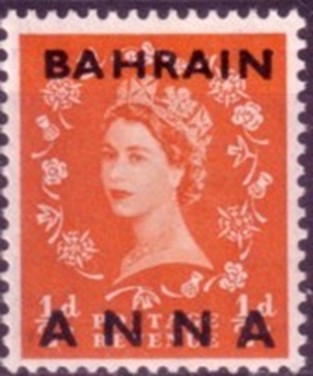
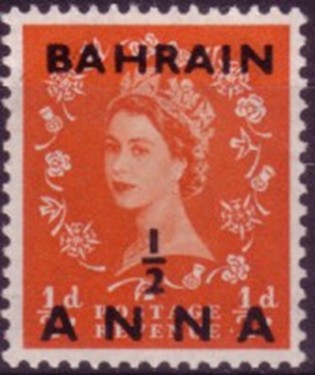
| Varieties | ||
| 80.v1 | “½” omitted | the fraction was applied as a separate pass and a number of sheets missed it; 2½ sheets (600 copies) have survived from the 3 sheets with the error, the other ½ sheet being withdrawn when found. Because of this method of overprinting the “½” can found in various positions relative to “AN”; only the ½ anna was overprinted in this manner, which also affects the equivalent “KUWAIT” overprinted ½ anna (qv), though that is not known with the fraction omitted. It is understood that this process was only used for the first print run. |
Coronation, 1953
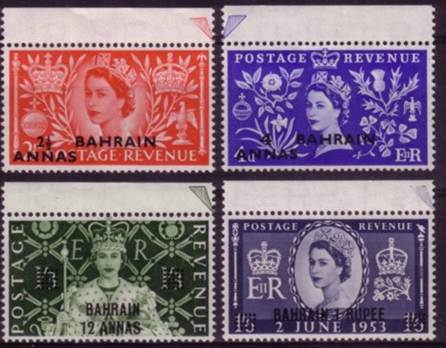
| (SG №) | denomination | colour | date of issue | number issued |
| 90 | 2½ annas on 2½d | red | 3 June 1953 | 184,417 |
| 91 | 4 annas on 4d | blue | 3 June 1953 | 182,626 |
| 92 | 12 annas on 1/3d | green | 3 June 1953 | 172,558 |
| 93 | R1 on 1/6d | dark blue | 3 June 1953 | 183,298 |
St Edward’s Crown watermark, Rupees and Annas, 1956


| (SG №) | denomination | colour | date of issue | number issued |
| 97 | ½ anna on ½d | orange | January 1957 | 137,760 |
| 98 | 4 annas on 4d | blue | 8 June 1956 | 32,640 |
| 99 | 6 annas on 6d | purple | 5 December 1956 | 189,840 |
| 100 | 12 annas on 1/3d | green | 2 August 1956 | 26,160 |
| 101 | R1 on 1/6d | dark blue | 4 March 1957 | 886,158 |
| 94 | R2 on 2/6d | brown | 23 September 1955 | 65,560 |
| 95 | R5 on 5s | red | 23 September 1955 | 42,920 |
| 96 | R10 on 10s | blue | 23 September 1955 | 44,480 |
Later printings of the high values
Waterlow printing

type I: bars very close together and aligned slightly to right of 1st vertical of “U”
type II: bars wider apart, aligned under left side of 1st vertical of “U”
type III: thinner letters than the Waterlow printings, bars much longer

type I: bars very close together and aligned slightly to right of 1st vertical of “U”
type II: bars wider apart, aligned further towards 1st vertical of “U”

type I: “1 0” slightly spaced, 0.9mm, overprint 34 mm
type II: “10” closer, 0.6mm, overprint 33½ mm
type III: similar overprint to the Waterlow printings, but a cleaner impression making it appear brighter, though published catalogues describe the colour as “dull ultramarine… with more blue and less ultramarine”. It is difficult to distinguish in isolation from a known Waterlow item. The Bahrain overprint is not known used (see The Overprinter 2010/1 p.17).
De La Rue printing

| (SG №) | denomination | colour | date of issue | number issued |
| Waterlow 2nd printing | ||||
| 94a | R2 on 2/6d, type II | brown | 13 May 1958 | 15,114 |
| 95a | R5 on 5s, type II | red | 19 August 1957 | 17,496 |
| 96a | R10 on 10s, type II | blue | 13 May 1958 | 5,040 |
| De La Rue printing | ||||
| 94b | R2 on 2/6d, type III | brown | 29 January 1960 | 9,407 |
| 96ab | R10 on 10s, type III | blue | 1960 | included in № 57 |
The R10 type III is not known used, the possibly unique mint sheet being understood to have been bought in Bahrain by a collector examining stocks in the local post office.


The apparent extra vertical line at the left of the “P” in this example is the “1” of the design, not part of the doubling.
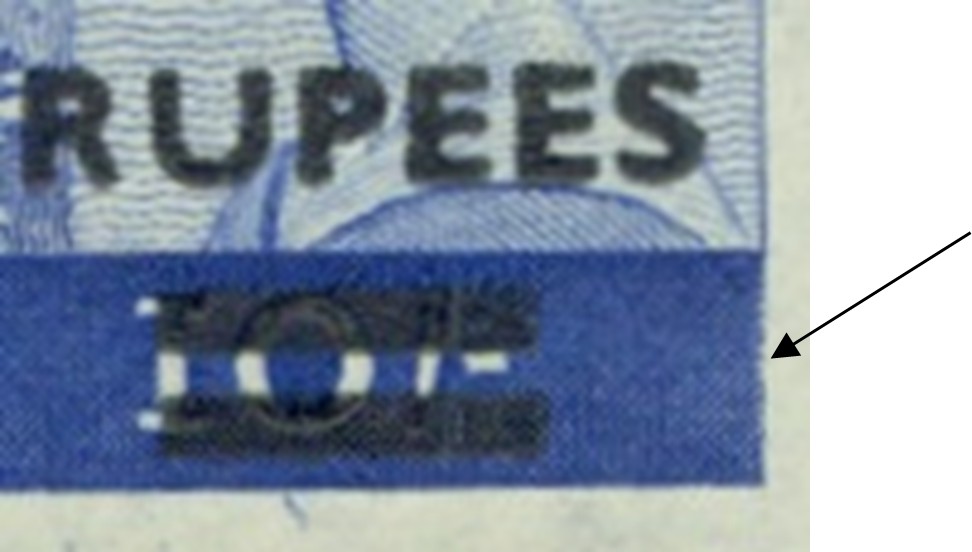
| Varieties | |||
| 101.v1 | R1 | overprint double | the two overprints are very close together, and it may be a “kiss-print”; for some years this was listed in some catalogues as being on Tudor watermark paper due to a faulty description in an auction catalogue |
| 96.v1 | R10 | weak entry | a weak entry showing as a ragged right‑hand edge of the value tablet (row 1, stamp 2) |
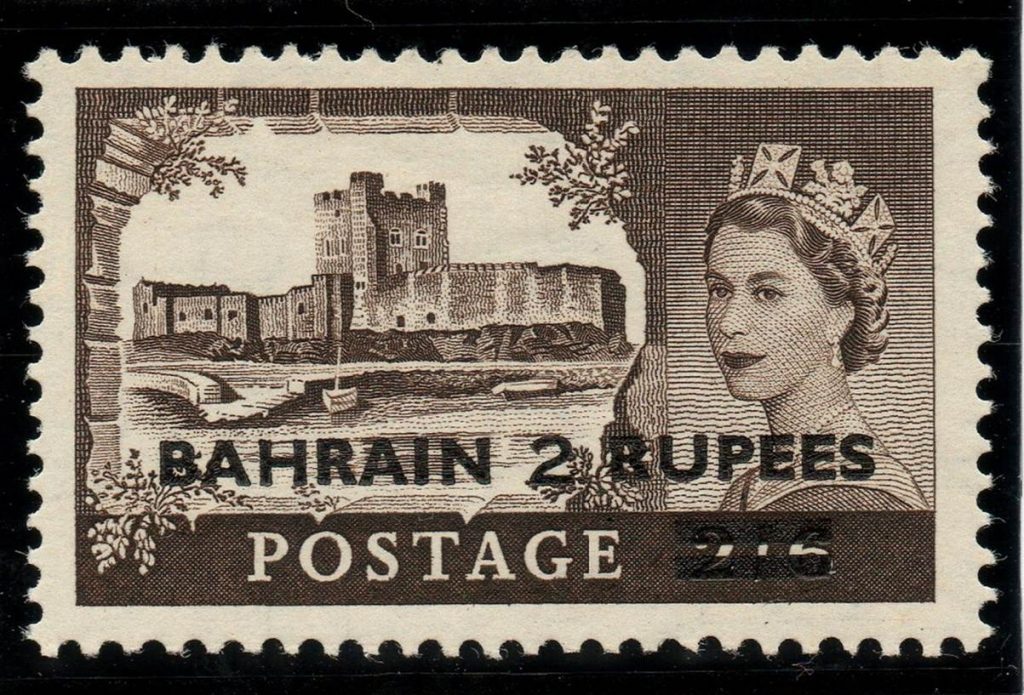
Decimal Currency, St Edward’s crown watermark, 1957
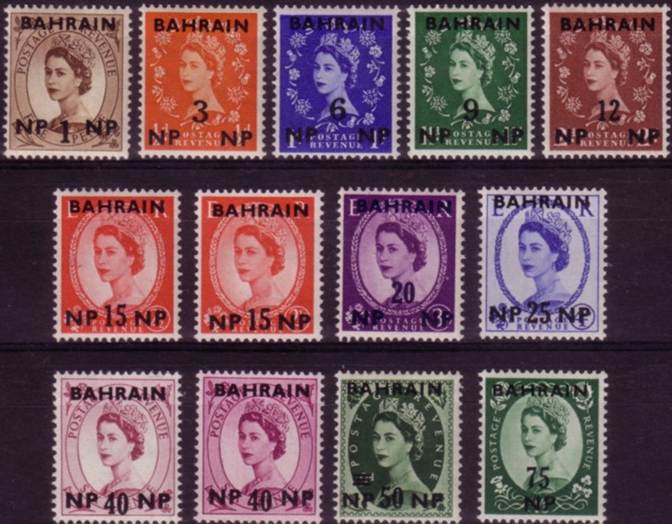
| (SG №) | denomination | colour | date of issue | number issued |
| 1np on 5d | brown | 1 April 1957 | 724,179 | |
| 103 | 3np on ½d | orange | 1 April 1957 | 181,548 |
| 104 | 6np on 1d | blue | 1 April 1957 | 158,133 |
| 105 | 9np on 1½d | green | 1 April 1957 | 191,285 |
| 106 | 12np on 2d | brown | 1 April 1957 | 129.542 |
| 107 | 15np on 2½d die I | red | 1 April 1957 | 524,010 |
| 107a | – die II | red | April 1959 | 300,480 |
| 108 | 20np on 3d (opt is in blue) | violet | 1 April 1957 | 1,992,697 |
| 109 | 25np on 4d | blue | 1 April 1957 | 144,786 |
| 110 | 40np on 6d | reddish purple | 1 April 1957 | 1,715,941 |
| 110a | claret | July 1959 | 570,720 | |
| 111 | 50np on 9d | deep green | 1 April 1957 | 94,477 |
| 112 | 75np on 1/3d | green | 1 April 1957 | 140,148 |
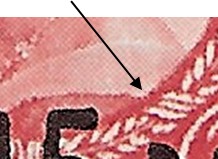
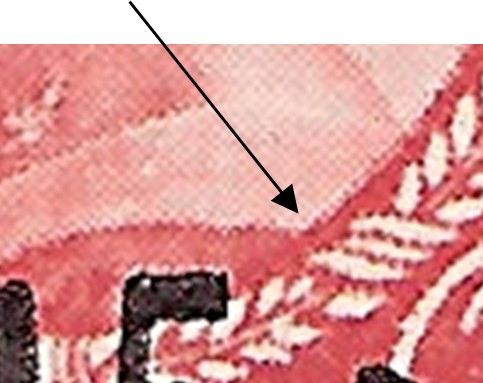
The 2½ annas on 2½d uses cylinder 46, which (uniquely) has a very slightly different version of die II compared to later cylinders, having a slightly different “tilt” to the portrait within the encircling wreath (see SG Specialised catalogue). Compare in the example with the St Edward’s crown EIIR watermark and the multiple crowns example below, using a good magnifying glass, the way the edge of the Queen’s collar points to the middle ribbon in the wreath (cyl 46) or the line separating the middle ribbon and the bottom ribbon (cyls 50 onwards). It does not require separate listing as cylinder 46 was used for all die II stamps on wmk St Edward’s crown EIIR, and cylinders 50 onwards are all on multiple crowns watermark, but it is of specialist interest. See also introduction paragraph xxx.
Scout Jamboree, 1956

| (SG №) | denomination | colour | date of issue | number issued |
| 113 | 15np on 2½d | red | 1 August 1957 | 167,764 |
| 114 | 25np on 4d | blue | 1 August 1957 | 161,783 |
| 115 | 75np on 1/3d | green | 1 August 1957 | 158,208 |
Decimal currency, multiple crowns watermark, 1960

| (SG №) | denomination | colour | date of issue | number issued |
| 116 | 15np on 2½d | red | 24 May 1960 | 36,840 |
Overprinted stamps were replaced by an inscribed set on 1 July 1960, but the British post office continued to run the postal administration until 31 December 1965.
References specific to this and related chapters
GBOS GB Overprints Compendium edition 8, Dr John Gledhill (12/4/2020)
Particular thanks go to Stanley Gibbons Ltd, for permission to quote their catalogue numbers and numerous other contributors who are mentioned in the Appendix section.
All content is copyright, Dr John Gledhill and the GB Overprints Society, May 2025.
GBOS Study Papers
Gulf No 1 British Post Offices in the Persian Gulf, M Phelan (November 1994)
Gulf supplement The Postal Agencies in Eastern Arabia and the Gulf (Supplement), Neil Donaldson (1994).
